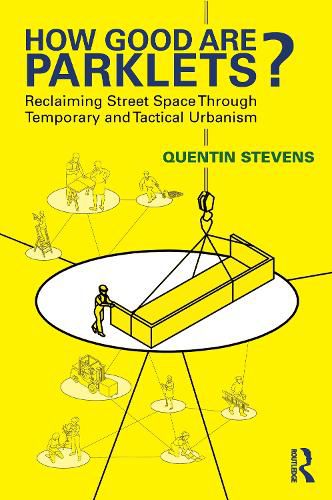Readings Newsletter
Become a Readings Member to make your shopping experience even easier.
Sign in or sign up for free!
You’re not far away from qualifying for FREE standard shipping within Australia
You’ve qualified for FREE standard shipping within Australia
The cart is loading…






Parklets are innovative, dynamic public spaces that are installed onto on-street car-parking spots. These very small spaces have had a very large and lasting impact on city streets. How Good Are Parklets? is the first book to critically examine the parklet's purposes, formats and impacts. It traces the parklet's history, from its invention in 2005 as an experiment that tactically reclaimed street space for broader public use, to its surge in popularity worldwide after the COVID-19 pandemic for outdoor dining, community gathering and play. Drawing together archival research, expert interviews, typological analysis, mapping, field observation and design research, this book examines parklets' design, production and implementation across varying urban contexts. By examining a wide range of contemporary practices, this book identifies parklets' potentials to reshape streets, meet diverse social needs and foster community engagement. This book situates parklets within the wider push towards deploying temporary and tactical strategies in the planning and management of cities. Its deep enquiry into one question about one type of spatial intervention contributes new insights into the complex interplays of actors, interests, processes and materials that are currently transforming the urban landscape - one parking space at a time.
$9.00 standard shipping within Australia
FREE standard shipping within Australia for orders over $100.00
Express & International shipping calculated at checkout
Parklets are innovative, dynamic public spaces that are installed onto on-street car-parking spots. These very small spaces have had a very large and lasting impact on city streets. How Good Are Parklets? is the first book to critically examine the parklet's purposes, formats and impacts. It traces the parklet's history, from its invention in 2005 as an experiment that tactically reclaimed street space for broader public use, to its surge in popularity worldwide after the COVID-19 pandemic for outdoor dining, community gathering and play. Drawing together archival research, expert interviews, typological analysis, mapping, field observation and design research, this book examines parklets' design, production and implementation across varying urban contexts. By examining a wide range of contemporary practices, this book identifies parklets' potentials to reshape streets, meet diverse social needs and foster community engagement. This book situates parklets within the wider push towards deploying temporary and tactical strategies in the planning and management of cities. Its deep enquiry into one question about one type of spatial intervention contributes new insights into the complex interplays of actors, interests, processes and materials that are currently transforming the urban landscape - one parking space at a time.